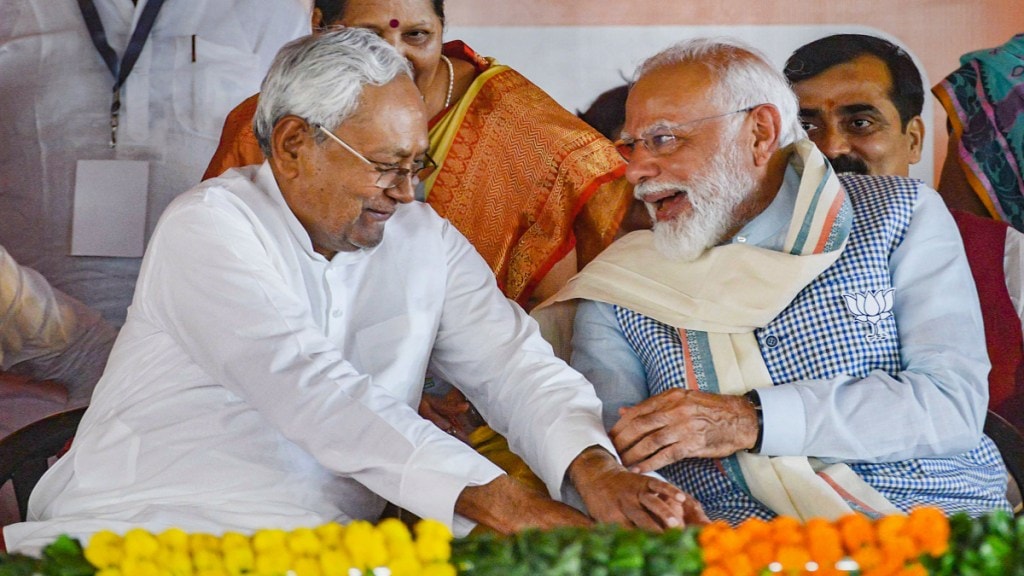Bihar Election Results 2025: The NDA is heading toward a record win in Bihar, with early numbers showing it could take around 208 of the 243 seats. This election took place after a well-planned campaign built around promises of stability, growth, and inclusion. The message of a “double-engine government” led by Prime Minister Modi and Chief Minister Nitish Kumar connected strongly with voters.
Turnout was unusually high, especially among women and young voters, who became key supporters. Their backing reflects years of welfare outreach and strong local mobilisation. Along with governance, the NDA also benefited from sharp political strategy, smooth seat-sharing within the alliance and reminders of the law and disorder associated with the old “Jungle Raj” period, which pushed many voters toward them.
The alliance grew even stronger by reaching out to many caste groups, not just the ones that usually support them. This broke old voting patterns and helped them tap into new support. The steady appeal of Nitish Kumar also played a big role, pushing JD(U) back into a leading position within the alliance.
Nitish-Modi leadership synergy
The idea of a ‘double-engine government’, Modi’s national image and Nitish Kumar’s record of steady governance, clearly helped the NDA. In the last stretch of the campaign, the alliance clearly presented Nitish as the only chief minister choice, which brought its workers together.
Many voters preferred stability instead of Tejashwi Yadav’s promises of youth and jobs. The NDA also reminded people of the lawlessness associated with the 1990s RJD rule, urging them not to risk a return to that period.
Women support and welfare schemes
Nitish Kumar’s JD(U) gained strong support from women through schemes like the Mukhyamantri Rozgar Yojna, which gave Rs 10,000 to 75 lakh women in September 2025. Earlier programmes, such as the liquor ban and the bicycle scheme for girls, also helped build this loyal base.
Women turned out to vote in huge numbers in the Bihar Assembly Elections 2025, crossing male turnout by more than five lakh, with their voting rate about 10% higher.
JD(U) rose from 43 seats in 2020 to 81 in 2025, doing especially well in areas with large EBC and SC populations. The women and EBC voters proved stronger than RJD’s oldermix of Muslim and Yadav voters.
Expanded caste coalition
The NDA stretched its reach far beyond the upper castes who usually back the BJP. Through JD(U), it brought in a large share of EBC voters, along with Kurmis and Dalits. LJP (RV)’s strong performance helped gather Paswan votes, and Upendra Kushwaha’s party added support from the Kushwaha community. Some Muslim and Yadav voters also shifted towards the alliance.
This wider social mix helped blunt anti-incumbency. By focusing on development instead of identity politics, the NDA even managed to win several seats with a heavy Muslim population.
Intact seat-sharing
The NDA’s big win in Bihar in 2025 was also sealed by a carefully planned seat-sharing agreement that was made well before the elections.
The alliance included BJP, JD(U), LJP (Ram Vilas), HAM(S), and RLM. The BJP and JD(U) contested 101 seats each, showcasing a balance of power between the two main partners. Smaller allies got fewer seats, like LJP (Ram Vilas) had 29, and HAM(S) agreed to six seats after initially asking for 15.
The arrangement was made smoothly, with all partners giving up some demands to avoid clashes, a common problem in multi-party coalitions. The focus was on quality over quantity, letting each party contest areas where they had strong support, which reduced vote-splitting and kept the alliance united. Leaders like Jitan Ram Manjhi publicly backed PM Modi and the NDA, showing solidarity.
This clear and precise seat-sharing helped the NDA run its campaigns efficiently across different castes and regions. It removed mistakes from past elections, where seat disputes weakened the alliance, and ensured the NDA’s vote share turned into a large number of seats, securing a record majority.
Getting rid of the ‘Jungle Raj’ Fear
During the campaign, the BJP-led NDA focused on reminding voters of the “Jungle Raj,” a period of lawlessness under Lalu Prasad Yadav and Rabri Devi from 1990 to 2005. Incidents such as the attack on Deputy CM Vijay Kumar Sinha’s convoy were highlighted as examples of political intimidation linked to the opposition, reinforcing fears about disorder.
Even though Bihar’s 2025 elections were the most peaceful in decades, with no repolls or violent clashes, the Jungle Raj narrative struck a chord with voters worried about instability. The NDA presented itself as the only choice to prevent a return to chaos, combining this message with promises of development, infrastructure growth, and industrial investment under PM Modi and Nitish Kumar. By linking law-and-order concerns with progress, the strategy successfully motivated a broad range of voters, especially those who remembered the turbulent past, strengthening support for the NDA.

